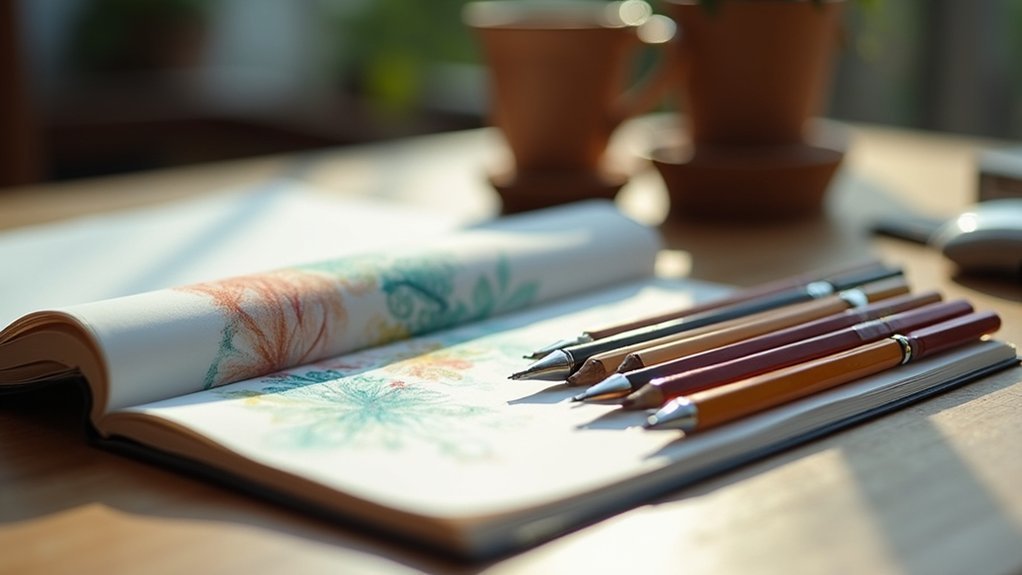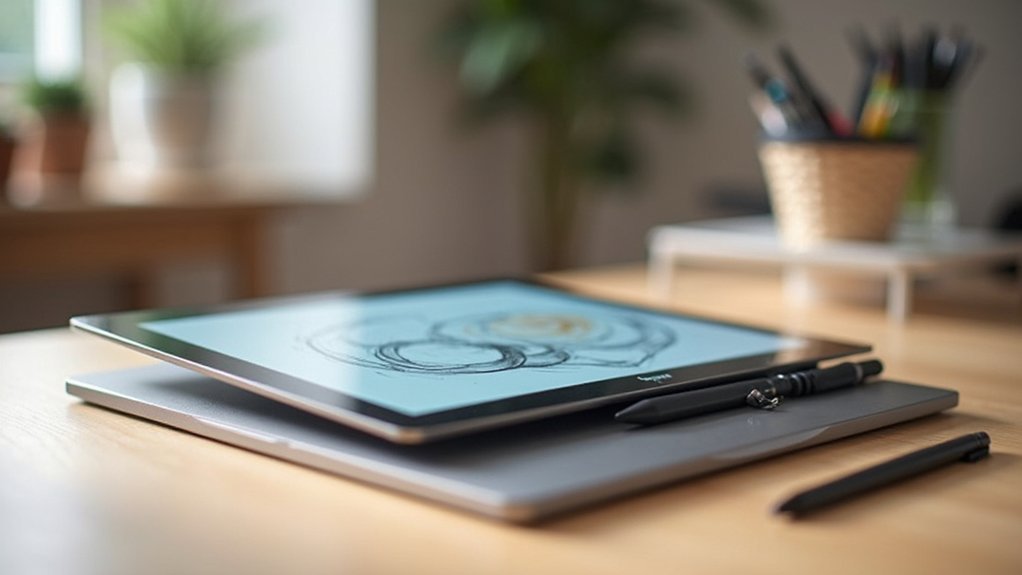Parkinson’s patients can maintain artistic expression with these specialized tools: weighted pens for hand stabilization, wide-grip drawing implements that distribute pressure, customized mahl sticks for steadying hands, foam-backed rulers for straight lines, magnetic drawing boards to secure materials, ergonomic grip adaptations for standard supplies, and digital tablets with tremor correction features. These adaptive options not only accommodate involuntary movements but can actually enhance body awareness and creative confidence as you explore your artistic potential.
Weighted Pens and Pencils That Reduce Tremors

While standard writing tools can be challenging for those with Parkinson’s, weighted pens and pencils offer significant relief from tremors that interfere with drawing and writing.
These specialized tools feature heavier barrels that stabilize hand movements by adding mass that counteracts involuntary shaking.
The science is simple: added weight creates stability, transforming trembling hands into instruments of precision.
You’ll find that the added weight increases proprioceptive feedback, heightening awareness of hand position and converting tremulous motions into more controlled movements.
Most weighted options include ergonomic grips that enhance comfort during extended use and reduce fatigue.
Look for pens with rollerball tips for smoother ink flow and mechanical pencils with thicker leads that require less frequent adjustment. For optimal results, choose pens with premium rollerball tips that provide an exceptionally smooth writing experience on various surfaces.
The balanced weight distribution provides consistent pressure on paper, improving precision and legibility while supporting your independence and creative expression.
Wide-Grip Drawing Tools for Enhanced Stability
Wide-grip drawing tools offer you significant therapeutic benefits through their ergonomic shape and material selection that distributes pressure across your hand.
You’ll find these tools particularly effective at stabilizing tremors through their broader contact area and specialized contours designed to accommodate involuntary movements.
The thoughtful design features, including soft pliable materials and multi-sensory textures, work together to enhance your grip stability while reducing hand fatigue during extended drawing sessions. Innovations like SteadyScrib demonstrate how ring magnets can provide additional stability for individuals with Parkinson’s disease tremors.
Therapeutic Grip Benefits
Stability begins with the right tool in hand. When you’re managing Parkinson’s symptoms, wide-grip drawing tools offer significant therapeutic advantages beyond just making art easier.
These specially designed handles work with your body, not against it. These tools are particularly beneficial as Parkinson’s disease often causes micrographia in patients, making normal writing and drawing challenging.
- Reduced tremor impact – wider grips provide enhanced stability, minimizing the effects of hand tremors
- Comfortable extended use – ergonomic designs distribute pressure evenly across your hand, preventing fatigue
- Personalized fit – adjustable grips accommodate your unique hand size and dexterity level
- Progressive improvement – regular use helps develop better hand-eye coordination and fine motor skills
- Decreased strain – soft, textured materials guarantee secure holding without requiring tight gripping
You’ll find these benefits extend beyond your drawing sessions, potentially improving everyday manual tasks through consistent practice.
Tremor-Reducing Design Features
Smart design elements transform ordinary drawing tools into powerful allies against Parkinson’s tremors.
Wide-grip designs greatly increase stability by distributing pressure evenly across your hand while reducing the effort needed to maintain control.
These specialized tools often incorporate weighted components that add inertia, effectively dampening involuntary movements. The additional mass makes your drawing tool less susceptible to shaking while maintaining smooth motion across the paper.
Anti-slip materials like textured silicone or soft rubber enhance your grip without causing fatigue, preventing accidental drops during tremor episodes. The correct grip style can significantly improve drawing precision for those with hand tremors.
Many options feature cushioned layers that absorb vibrations from hand movements.
For maximum benefit, look for tools that integrate with stabilizing devices such as magnetic clipboards, which keep paper firmly in place while you focus on creating your artwork.
Customized Mahl Sticks to Steady the Artist’s Hand

Customizing your mahl stick’s design specifically for Parkinson’s needs can dramatically improve your artistic control and expression.
You’ll want to contemplate extending the length to 4-5 feet, allowing you to brace it between your knees or feet for maximum stability.
Attaching a tennis ball to the tip creates an ideal cushioned contact point that won’t damage your artwork while providing the steady anchor your hand requires.
Covering the tennis ball with a leather chamois offers additional protection for your painting surface while maintaining the necessary grip.
Design Features Matter
When creating tools for artists with Parkinson’s disease, thoughtful design of the mahl stick can make the difference between frustration and creative fulfillment.
Your ideal mahl stick should incorporate specific features to accommodate tremors while providing maximum stability and comfort.
- Extend the length to 4-4.5 feet, allowing you to brace it between your knees or feet for peak stability.
- Use a tennis ball wrapped in soft leather chamois at the tip for surface protection and enhanced grip.
- Choose lightweight yet sturdy materials to prevent additional fatigue during extended use.
- Verify padding materials like leather chamois provide smooth hand movement.
- Consider ergonomic shapes with padded grips to reduce strain on weakened hands and wrists.
These adaptations will help maintain your artistic expression despite motor challenges. A well-designed mahl stick can effectively reduce tremors during art activities, potentially contributing to the documented physical benefits of regular art therapy for Parkinson’s patients.
Tennis Ball Adaptations
Tennis ball adaptations represent one of the most accessible and effective modifications for artists with Parkinson’s.
By attaching a tennis ball to the end of a mahl stick, you’ll create a cushioned, non-slip support that steadies your hand above the canvas.
The ball’s soft texture absorbs micro-movements while providing stability during detailed work.
You’ll find this approach considerably cheaper than specialized tools yet remarkably effective at counteracting tremors.
Your custom adaptation can combine with weighted attachments for additional stabilization.
Artists report improved control, reduced fatigue, and longer creative sessions when using these supports.
You can easily modify, replace, or clean tennis balls as needed, making this solution practical for regular use.
Consider experimenting with different ball densities to find the perfect balance of support for your specific needs.
Placing your materials on non-slip mats will further enhance stability while working on your tennis ball adaptation project.
Foam-Backed Rulers and T-Squares for Straight Lines
For Parkinson’s patients who struggle with drawing straight lines, foam-backed rulers and T-squares offer substantial benefits as assistive tools.
These devices provide stability and precision that can help manage tremors while creating art. Focusing on body awareness and positioning can significantly enhance your ability to use these tools effectively.
The strategic use of adaptive tools offers essential stability, turning artistic challenges into manageable drawing experiences for those with tremors.
- Foam-backed rulers won’t slip on your drawing surface, giving you greater control during line work.
- T-squares can be braced against the edge of your canvas for additional stability.
- Both tools reduce hand fatigue by minimizing the need for constant readjustments.
- You’ll find these items are cost-effective and readily available at most art supply stores.
- Combine these tools with proper ergonomic seating for maximum effectiveness.
When integrated with other adaptive techniques, foam-backed rulers and T-squares can greatly improve your drawing experience, allowing you to create precise lines despite tremors.
Magnetic Drawing Boards and Clipboards for Secure Work Surfaces

Magnetic drawing boards and clipboards provide two essential secure work surfaces that can dramatically transform the drawing experience for Parkinson’s patients.
These tools counteract micrographia and stabilize your drawing materials, reducing unintended movement while offering helpful tactile feedback for those with tremors.
You’ll find both options aid in fine motor control by anchoring your materials firmly, allowing smoother pen movements and more consistent line quality.
Their stability supports repetitive practice vital for motor learning and symptom management.
Research shows impressive results, with digitalized assessments on stable surfaces detecting PD-related motor dysfunction with up to 97.52% accuracy.
These lightweight, ergonomic tools integrate easily with art therapy programs and can help track your symptom progression over time while improving your mood and motivation. When incorporated into structured art therapy sessions, these tools can contribute to the significant improvement in nonmotor symptoms that has been documented in Parkinson’s patients.
Ergonomic Grip Adaptations for Standard Art Supplies
Ergonomic adaptations transform standard art supplies into powerful allies for Parkinson’s patients dealing with tremors and reduced grip strength. You don’t need specialized equipment to continue creating art—simple modifications can make your existing tools more accessible.
Art-making remains accessible through simple tool modifications, empowering Parkinson’s patients to continue their creative expression despite physical challenges.
- Slide foam tubing over pencils, pens, and brushes to enlarge handle diameter for a more secure grip.
- Add pencil grippers or holder rings to improve stability and control while counteracting tremors.
- Secure brushes to fingers with tape for custom leverage when traditional gripping isn’t possible.
- Try universal grip aids like Functionalhand cuffs that enable tool use without active finger closure.
- Consider wrapping handles with silicone or rubber materials to decrease required grip force and reduce muscle strain.
Similar to adaptive clothing options from Tommy Hilfiger and Silverts that use magnetic closures for easier dressing, these tools can be customized to your specific needs.
These affordable adaptations can greatly improve your comfort and precision while drawing or painting.
Digital Drawing Tablets With Stabilization Features

Digital drawing tablets offer a technological leap forward for Parkinson’s patients seeking precision and confidence in their artistic expression. These devices combine hardware and specialized software that filter tremor-induced movements while preserving intentional strokes.
With high-resolution stylus input and low latency response, these tablets track your hand movements accurately while adaptive algorithms remove unsteady lines. The data collected also helps monitor your condition over time, providing valuable insights for healthcare providers. Some advanced tablets can be used to conduct tests similar to the Stability Test used in clinical research to assess hand tremor levels.
| Feature | Benefit | Application |
|---|---|---|
| Tremor stabilization | Smoother lines and curves | Detailed artwork creation |
| Pressure sensitivity | Distinguishes tremors from deliberate strokes | Variable line thickness control |
| Palm rejection | Prevents unintended input | Comfortable hand positioning |
Most systems include adjustable settings to match your specific tremor patterns, ensuring you can express yourself artistically despite motor challenges.
Frequently Asked Questions
How Affordable Are Specialized Art Tools for Parkinson’s Patients?
You’ll find specialized art tools quite affordable, with prices ranging from $9.99 for basic sets to $29.99 for extensive options. The therapeutic benefits they provide greatly outweigh their relatively low cost.
Can Tremor-Reducing Art Tools Benefit Other Neurological Conditions?
Yes, you’ll find tremor-reducing art tools beneficial for multiple sclerosis, cerebral palsy, and post-stroke tremors. They work by stabilizing hand movements, which improves fine motor control across various neurological conditions beyond essential tremor.
Where Can Caregivers Find Training for Assisting With Adaptive Art Tools?
You’ll find caregiver training for adaptive art tools through Parkinson’s Foundation, Trualta, COHME, local art groups, and online workshops. Healthcare providers and community partnerships also offer specialized resources for assistive techniques.
How Do Art Therapists Incorporate These Tools Into Treatment Plans?
Art therapists incorporate adaptive tools by designing personalized exercises to improve your fine motor skills, encourage emotional expression, provide sensory stimulation, and foster social interaction, all while adapting techniques to match your specific limitations and strengths.
Are There Community Workshops Specifically for Parkinson’s Artists?
Yes, you’ll find dedicated community workshops like “Painting with Parkinsons” that provide structured art therapy specifically for people with Parkinson’s. They’re designed to reduce symptoms, combat isolation, and foster connections through creative expression.
In Summary
You’ve seen how the right tools can transform your artistic experience despite Parkinson’s challenges. Whether you’re choosing weighted pens, grip adaptations, or digital tablets with tremor-reducing features, you’ll find options that work for your specific needs. Don’t let tremors stop your creativity—these specialized drawing tools will help you maintain control and continue expressing yourself through art for years to come.





Leave a Reply